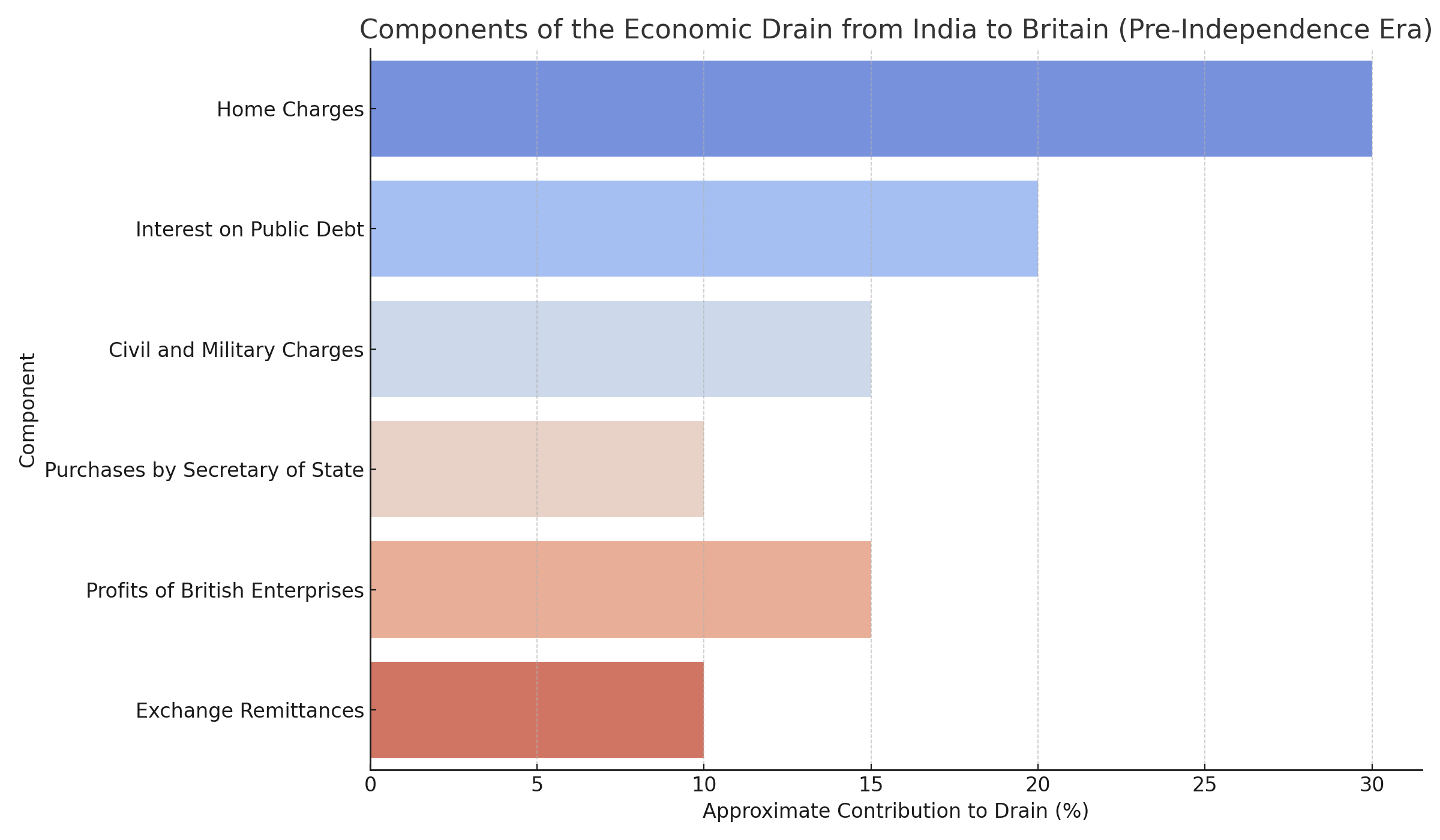
30 Jul Drain Theory in Indian Economy
Drain Theory in Indian Economy (Pre-Independence Era)
Introduction
The Drain Theory is one of the most significant economic critiques of British colonial rule in India. It refers to the systematic transfer of wealth from India to Britain without any corresponding economic return. This “drain” of wealth, as articulated by Indian nationalists and economists, became a foundational argument in the Indian freedom struggle. Understanding Drain Theory is crucial for students of Indian Economic History and especially for aspirants of the UPSC Civil Services Examination.
Origin and Development of the Theory
The concept of the economic drain was first propounded by Dadabhai Naoroji, also known as the “Grand Old Man of India.” In his landmark work, Poverty and Un-British Rule in India (1901), Naoroji quantified and explained how India’s wealth was being siphoned off to England. He argued that British rule brought no economic gains to India but led to financial hemorrhage.
Other prominent economists like R. C. Dutt, G. V. Joshi, and M. G. Ranade expanded on this theory, using it as an analytical tool to explain colonial impoverishment of India.
Best ias coaching in hindi medium
Key Components of the Drain
- Home Charges: Payments made to Britain for administrative expenses, pensions, and interest on debt.
- Interest on Public Debt: India paid for loans raised in Britain and serviced entirely in sterling.
- Civil and Military Expenditures: Salaries, pensions, and expenses of British officers were paid from Indian revenues.
- Purchases by the Secretary of State: Indian goods were bought using Indian revenue but paid in England.
- Profits of British Enterprises: Railways, plantations, banking, and trading profits were repatriated to Britain.
- Remittances by British Officials: Salaries earned in India were often remitted to Britain for personal savings and family maintenance.
Infographic: Breakdown of Economic Drain
Estimates and Quantification
Dadabhai Naoroji estimated that approximately ₹8 crore to ₹30 crore were drained annually during different periods of British rule. This drain represented up to 6-7% of India’s national income, which had severe repercussions on capital formation and living standards.
Mechanisms of the Drain
- Exchange Manipulation: Unfavorable exchange rates drained India’s silver reserves.
- Export Surplus with No Return: India exported goods but the earnings were retained in England.
- Employment of British Personnel: Dominance of British officials in civil and military administration led to outflow of salaries.
Economic Consequences
1. Depletion of National Wealth
Continuous transfer of wealth depleted India’s resources and constrained domestic investment.
2. Stunted Industrial Growth
Lack of capital formation prevented the emergence of an indigenous industrial base.
3. Increase in Poverty and Famines
With resources leaving the country, the colonial state failed to create safety nets for agriculture, leading to famines and worsening poverty.
4. Weak Infrastructure for Indians
Railways and telegraphs were built not for Indian development but for British strategic and commercial interests.
Drain Theory and the Indian National Movement
Drain Theory laid the foundation of early economic nationalism. The economic critique of colonialism strengthened the demands for Swadeshi, Swaraj, and self-reliance. Leaders like Gopal Krishna Gokhale and Bal Gangadhar Tilak used this theory in Congress debates to demand constitutional reforms.
- Indian National Congress: Economic drain was a recurring theme in INC’s early resolutions.
- Swadeshi Movement: Inspired by the idea that Indian wealth must stay in India.
- Moderate Phase: The early moderates largely focused on economic arguments rather than political demands.
Mind Map
Drain theory of Indian economics
Criticism of the Drain Theory
1. Imperialist Viewpoint
British scholars claimed that India received security, legal system, and infrastructure in return.
2. Overestimation Argument
Some critics believed Naoroji overestimated the extent of the drain and ignored certain reinvestments.
3. Modern Reassessment
Postcolonial economists largely validate the drain theory, though estimates and mechanisms are refined.
Contemporary Relevance
The Drain Theory has regained attention in the context of reparations debates, with leaders and scholars questioning the long-term economic impact of colonialism on developing countries.
Best economics optional coaching for upsc
Important Books & Reports
- Poverty and Un-British Rule in India – Dadabhai Naoroji
- The Economic History of India – R. C. Dutt
- Royal Commission on Indian Expenditure (1896)
- Congress Economic Resolutions (1890s–1920s)
Previous Year Questions (PYQs)
- Critically examine the Drain Theory of Dadabhai Naoroji. (UPSC CSE 2016, 15 Marks)
- Explain the economic impact of British colonial policies with special reference to the Drain of Wealth. (UPSC CSE 2013, 12 Marks)
- What was the significance of Drain Theory in India’s freedom struggle? (UPSC CSE 2020, 10 Marks)
Probable Questions for Upcoming Exams
- Discuss the role of Drain Theory in shaping early Indian nationalism.
- Analyze the components and mechanisms of economic drain from India under British rule.
- To what extent did the Drain Theory explain India’s underdevelopment during colonial rule?
- Compare and contrast the views of Dadabhai Naoroji and R. C. Dutt on the economic drain.




No Comments